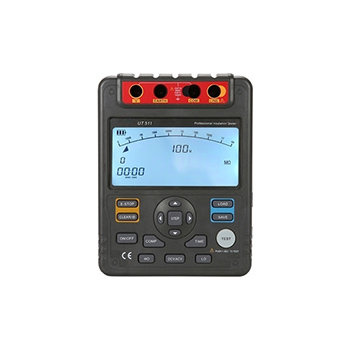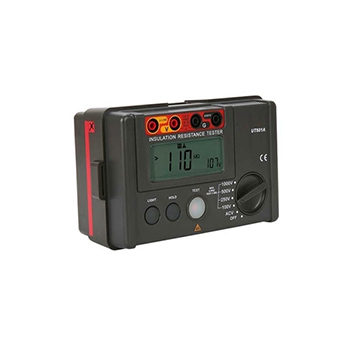Using Tips of Insulation Resistance Tester
Insulation resistance tester, also known as Megohmmeter or Megger. The scale of the megohmmeter is in megohms. The megger consists of medium and large scale integrated circuits. Megohmmeters are commonly used and indispensable instruments for electric power, post and telecommunications, communications, electromechanical installation and maintenance, and industrial enterprises that use electric power as industrial power or energy. It is suitable for measuring the resistance of various insulating materials and the insulation resistance of transformers, motors, cables and electrical equipment.
Today, we will introduce the using tips of the insulation resistance tester. We hope that after reading this article, you can have a clear understanding of the megger.
Preparation before use
- Before use, the positions of the switches on the panel should be as follows:
The test voltage switch is placed at "10V", and the magnification switch is placed at the lowest position. Discharge - Test switch is in "discharge" position and power switch in "off" position. The input short circuit switch is placed in the "short circuit" position, and the step switch is placed in the "0" position.
- Check whether the temperature and humidity of the test environment are within the allowable range. Especially when the ambient humidity is higher than 80%, the micro-current may cause larger errors when measuring higher insulation resistance.
- Check whether the AC power voltage meets the tolerance of 220V ±10%.
- The grounding terminal of the instrument should be properly grounded with a wire.
- Connect the instrument to the power supply, close the power switch, the indicator light will be on, and there will be a beeping sound. If the indicator light is not on, cut off the power immediately and use it only after the cause is found out.
- Turn on the power for about 30 minutes. Place the polarity switch at "+". (For general tests, it is placed at "+". And it is placed at "-" only when testing negative polarity microcurrent.) It may be found here that the pointer of the indicator will leave the "∞" and "0" positions. At this time, you can slowly adjust the "0" and "0" potentiometers, so that the pointer is placed at the "∞" and "0" positions, until no longer Change again.
- Turn the magnification selector switch from the ×102 position to the "full scale" position. (The input switch should be turned to open circuit at this time.) Then the pointer will point to "full scale" from the "∞" position. If the "full scale" is less than or exceeded, the "full scale" potentiometer can be adjusted to make it "full scale". Then turn the magnification switch to ×102, so that the pointer still points to "∞" and "0". This is repeated many times to adjust the sensitivity of the instrument. In the test, the full scale and "∞" should be checked frequently to ensure the test accuracy of the instrument.
Using tips
The tips for the use of the insulation resistance tester are as follows:
- Correctly select its voltage and measurement range.
- When selecting the external wire of the megohmmeter, a single copper wire should be used. The insulation strength of the wire is required to be above 500V, so as not to affect the accuracy.
- When measuring the insulation resistance of electrical equipment, the power supply of the equipment must be disconnected first, and the measurement should be performed in the absence of electricity. For longer cable lines, it should be measured after discharge.
- The megger should operate with strong magnetic field and lay flat.
- Before measuring, the megger should accomplish an open circuit test and a short circuit test. The needle should point to infinity in the open-circuit test, but it can point to zero in the short-circuit test, indicating that the megger is in normal working condition before measuring electrical equipment.
- During measurement, the electrical surface to be measured should be cleaned to avoid high contact resistance and error in measurement results.
- When measuring capacitors, it should be noted that the withstand voltage of the capacitor must be greater than the voltage value issued by the megohmmeter. After measuring the capacitance, the cable of the megohmmeter must be removed first and then stop shaking to prevent the charged capacitor from being damaged by discharging to the megohmmeter. The measured capacitor should be discharged.
- When the megohmmeter is measuring, it should be noted that the L terminal on the megohmmeter is connected to one end of the live body of the electrical equipment, and the terminal marked E grounding should be connected to the shell or ground wire of the equipment.

When measuring the insulation resistance of the cable, in addition to connecting the ground end of the megohmmeter to the ground of the electrical equipment, the other end is connected to the line. The inner layer of insulation between the cable cores should be connected to the protection ring to eliminate surface leakage and avoid reading errors. - When the weather is wet, a protection ring should be used to eliminate leakage on the surface of the insulator, so that the measured insulation resistance is lower than the actual value.
- After using the megger, discharge the electrical equipment once.
- When using a megohmmeter, a certain speed must be maintained. According to the regulations of the megger, it is generally about 120r/min, and a stable reading is taken after 1min. Do not touch the object to be measured and the terminals of the megger with your hands during measurement to prevent electric shock.
- Shake the handle of the megger, it should be slow first and then fast. After the governor slips, the speed should be kept stable. If the device under test is electrically short-circuited, when the needle swings to "0", it should stop shaking to prevent the megohmmeter from over-current and burning out.

